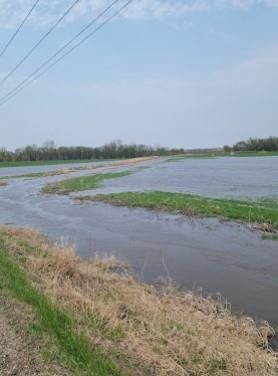By Anthony Hanson and Jeff Coulter et.al
A large swath of central Minnesota saw 4 to 7 inches of rain between May 7-14, with some locations reporting over 8 inches. This resulted in heavily flooded fields with standing water, even on sandy soils, or heavy runoff on hillsides. This all occurred only recently after conditions were finally fit for planting, especially for corn. This has left many growers asking how long recently planted seeds can survive underwater or in heavily saturated soil, and if there is any action they should be taking now, especially if soil crusting is a concern.

Heavy flooding and ponding in central MN
meadows and fields. Photo: Adam Austing
near Howard Lake, Wright County.
Flooding
Whether a seed or seedling survives flooding is based on the length of time that flooding lasts and the soil temperature. Warmer temperatures increase plant respiration and decrease the viability period for submerged plants. Seed and small seedlings can usually survive two to four days, sometimes more than a week if temperatures are cool and leaves are exposed, but they respire faster at high temperatures (upper 80s and 90s) and can be killed in as little as a day.
Crusting
If soils crust and corn coleoptiles begin to burst with underground leafing, consider running through the field with a rotary hoe or drag. Be proactive if the crusting is significant. These field operations can be performed up to and during emergence of corn, but in soybean they should be completed before the crook is near the soil surface. However, high population densities of soybeans can often push through a crust better than corn or small-seeded crops. Additional rainfall can help soften the soil. Packed or crusted soils are also prone to blowing and cutting off emerged plants. A rotary hoe can help roughen the soil surface and slow soil movement.
Nitrogen
Fields that receive high amounts of rainfall can have considerable nitrogen loss due to leaching and denitrification. Areas with ponding are at high risk of nitrogen losses due to denitrification, especially when ponding lasts for an extended duration of time and when the soil temperature is warm.
If a corn crop is able to be established in such field areas, it should be monitored for nitrogen deficiency symptoms. Plants exhibiting nitrogen deficiency often have an overall lighter-green color and yellowing along the mid-rib of the lower leaves, beginning at the tips of the leaves. Such field areas may require a supplemental application of sidedressed nitrogen fertilizer for corn. The Corn calculator helps assess whether or not supplemental nitrogen is recommended.
Seed and seedling diseases
Seedling diseases can increase with flooded or saturated soils. Favorable conditions for seedling diseases include wet and compacted soils, slow plant emergence and growth, crusted soil, and poor seed quality. For example, Phytopthora can damage soybean seedlings in the spring, or this pathogen can infect seedlings with few symptoms and then develop and kill plants later in the season.
Other moisture-loving pathogens like Pythium, primarily damage and kill seedlings. With late planting into moist and warming soil, the risk of Rhizoctonia root and stem rot also increases. These and other seedling diseases are difficult to diagnose by themselves, and can sometimes be confused for nutrient deficiencies or other stresses that can occur in wet soils, so be sure to have potential disease concerns diagnosed properly. Seed treatment efficacy should be evaluated if there is stand loss due to seedling diseases where seed treatment fungicides were used. But the challenges with diagnosing stand loss and determining definite pathogen involvement will make conclusions difficult.
Source : umn.edu